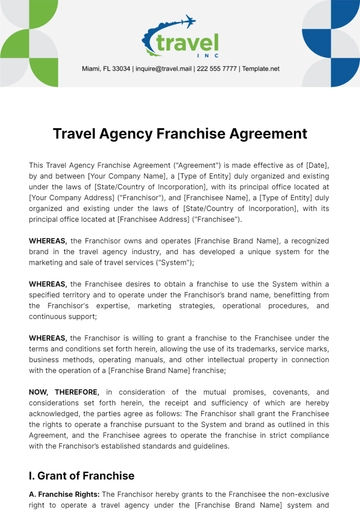New Franchise Project Specification
Prepared By: [YOUR NAME]
Date: [DATE]
I. Executive Summary
This document details the plan to launch a new franchise aimed at expanding our business model through a franchise network. Our objective is to grow our brand, ensure operational consistency, and deliver high-quality products and services while achieving sustainable profitability.
II. Business Model and Concept
A. Business Model
Our franchise model enhances both profitability and brand strength through the implementation of several key strategies and practices, including the following:
B. Products and Services
Product/Service Line | Details |
|---|
Product Line 1: Gourmet Coffee and Specialty Teas | Signature Coffee Blends: Exclusive blends from premium coffee regions, offering a unique, high-quality experience. Specialty Teas: Curated selection of rare and exotic teas for enthusiasts and casual drinkers.
|
Product Line 2: Freshly Baked Pastries and Snacks | |
Service Line 1: Barista Training Workshops | Professional Development: Advanced barista workshops: brewing techniques and customer service. Certification Programs: Certification opportunities to ensure staff proficiency and enhance franchise credibility.
|
Service Line 2: Customized Catering for Events | Tailored Solutions: Custom catering for events, featuring gourmet coffee and pastries. Event Planning Support: Event planning and coordination for a seamless and memorable experience.
|
III. Market Analysis
A. Target Market
B. Competition
C. Market Trends
IV. Operational Plan
A. Staffing
Training: Implement a thorough training program covering product preparation, exceptional customer service, and adherence to operational procedures. This includes onboarding and periodic refreshers to maintain high standards.
B. Supply Chain Management
Logistics: Develop efficient logistics and inventory management systems, including reliable delivery schedules and real-time inventory tracking, to maintain product freshness and minimize disruptions.
C. Customer Service Standards
V. Marketing and Sales Strategy
A. Marketing Plan
Social Media Campaigns: Launch targeted advertising campaigns on platforms like Instagram and Facebook, highlighting new products, promotions, and brand stories to engage and attract customers.
Promotions and Discounts: Offer grand opening specials, customer loyalty programs, and seasonal promotions to attract and retain customers, encouraging repeat business and word-of-mouth referrals.
B. Sales Activities
VI. Financial Projections
A. Startup Costs
Item | Estimated Cost |
|---|
Franchise Fees | $50,000 |
Initial Inventory | $30,000 |
Store Build-Out | $70,000 |
Marketing Expenses | $20,000 |
B. Revenue Projections
Forecast for the first year:
Month | Revenue |
|---|
Month 1 | $10,000 |
Month 2 | $12,000 |
Month 3 | $14,000 |
Month 4 | $16,000 |
Month 5 | $18,000 |
Month 6 | $20,000 |
Month 7 | $22,000 |
Month 8 | $24,000 |
Month 9 | $26,000 |
Month 10 | $28,000 |
Month 11 | $30,000 |
Month 12 | $32,000 |
First-year revenue projections show steady growth from $10,000 in Month 1 to $32,000 by Month 12, reflecting effective business strategies and strong market potential, with a positive outlook for continued expansion.
C. Profit Margins
First Year: 15%
Second Year: 20%
Third Year: 25%
VII. Legal and Compliance Requirements
A. Franchise Agreements
Detailed legal documents will be drafted to outline the terms and conditions of the franchise relationship. These agreements will cover franchisee obligations, brand usage, operational standards, and dispute-resolution mechanisms. All parties must review and sign these agreements to formalize the partnership.
B. Regulatory Compliance
Our franchise operations will adhere to all applicable local, state, and federal regulations. This includes compliance with labor laws, health and safety standards, zoning requirements, and industry-specific regulations to ensure legal and operational integrity.
VIII. Training and Support
A. Initial Training
Franchisees and their teams will undergo an extensive training program that covers essential business aspects such as operational procedures, customer service excellence, and effective sales techniques. This training is designed to ensure consistency and high standards across all franchise locations.
B. Ongoing Support
We will provide continuous support through regular consultations, updates, and additional training sessions. This ongoing support aims to address any challenges, implement improvements, and keep franchisees aligned with brand standards and business objectives.
IX. Brand Guidelines
Ensuring consistency in brand presentation is essential for franchise success, so all franchisees will strictly follow the set brand guidelines, which cover aspects like branding, marketing materials, store design, and customer experience, thereby creating a unified and recognizable brand image that enhances customer loyalty and promotes the franchise's growth and success.
X. Implementation Timeline
Period | Activities |
|---|
Month 1-2 | Initial Planning and Research: Develop a business plan, secure funding, and begin franchise recruitment. |
Month 3-4 | Legal Documentation and Franchisee Recruitment: Draft and finalize franchise agreements, and recruit initial franchisees. |
Month 5-6 | Site Selection and Store Build-Out: Identify and lease locations, commence store construction and design. |
Month 7-8 | Training and Marketing Launch: Conduct franchisee training, execute pre-opening marketing campaigns. |
Month 9 | Grand Opening: Launch the first franchise location with promotional events and media coverage. |
Ongoing | Continuous Support and Monitoring: Provide ongoing support, monitor performance, and adjust strategies as needed. |
Project Specification Templates @ Template.net






























